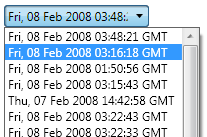Styling the ScrollViewer
I recently got a comment asking if I could do something on creating a Blend-type ScollViewer styling. The only problem is that the ScrollViewer is a multi-post affair, which I’ll… Read More »Styling the ScrollViewer
I recently got a comment asking if I could do something on creating a Blend-type ScollViewer styling. The only problem is that the ScrollViewer is a multi-post affair, which I’ll… Read More »Styling the ScrollViewer
This is a post that has taken months to complete, but addresses something that I don’t think I’ve seen sufficiently covered for anyone who is new to WPF. Resultantly, we’re… Read More »WPF Designers Guide to Styles And Templates
The ComboBox is not the most complex of the WPF applications, but it can be a little tricky, so lets do a general overview post of it before we go into the specifics of how we’re going to make it work.
First of all, if you’re going to test your comboBox design, you should have it hooked up to an ItemsSource. Don’t have one? I have a tutorial in which I walk through attaching an RSS feed to your control. It was originally written for the ListView, but it will work fine for a ComboBox.
To start out… this is your standard ComboBox:

When working on a comboBox, you have a couple of options for the Items inside the ComboBox. If the options never change and are not data-driven, you can just toss come ComboBoxItems into it. Otherwise, you can connect it to some kind of ItemsSource (see the link above).
All of my examples are done with a data-driven ComboBoxes, but you should get the desired results if you run through the tutorials with ComboBoxItems.
First, a little bit about the structure of the comboBox.
So, after months of delay I finally figured that there are probably some people out there who want to figure out how to make the WPF listview look the way they want it to look.
A quick note: I will be dealing almost entirely with the listview look. If you want the listview to do something (functionality) or look a certain way and you can’t find the answer here, leave a comment with your suggestion and I’ll try to blog about it and place a link to the answer in my listview FAQ.
My goal is to create a significant repository on getting the stinking listview to look the way you want and do what you want it to do.
You’re probably here because, compared with most of the WPF controls, Blend gives very little guidance on how to deal with the listview (even though you use the listview for practically everything you do). So we’re going to start with the basic structure of the listview. This is what the basic listview looks like in the XAML.
<ListView>
<ListView.View>
<GridView>
<GridViewColumn Header=”Column Header“/>
</GridView>
</ListView.View>
</ListView>
So this post will start out giving basic guidance on what to edit when you’re trying to edit the various parts of the listview. I will update these sections with links and tutorials on listview specific tasks as time goes on.
Read More »The WPF Designer Guide To Styling the (your-favorite-adjectival-swear-word-here) ListView